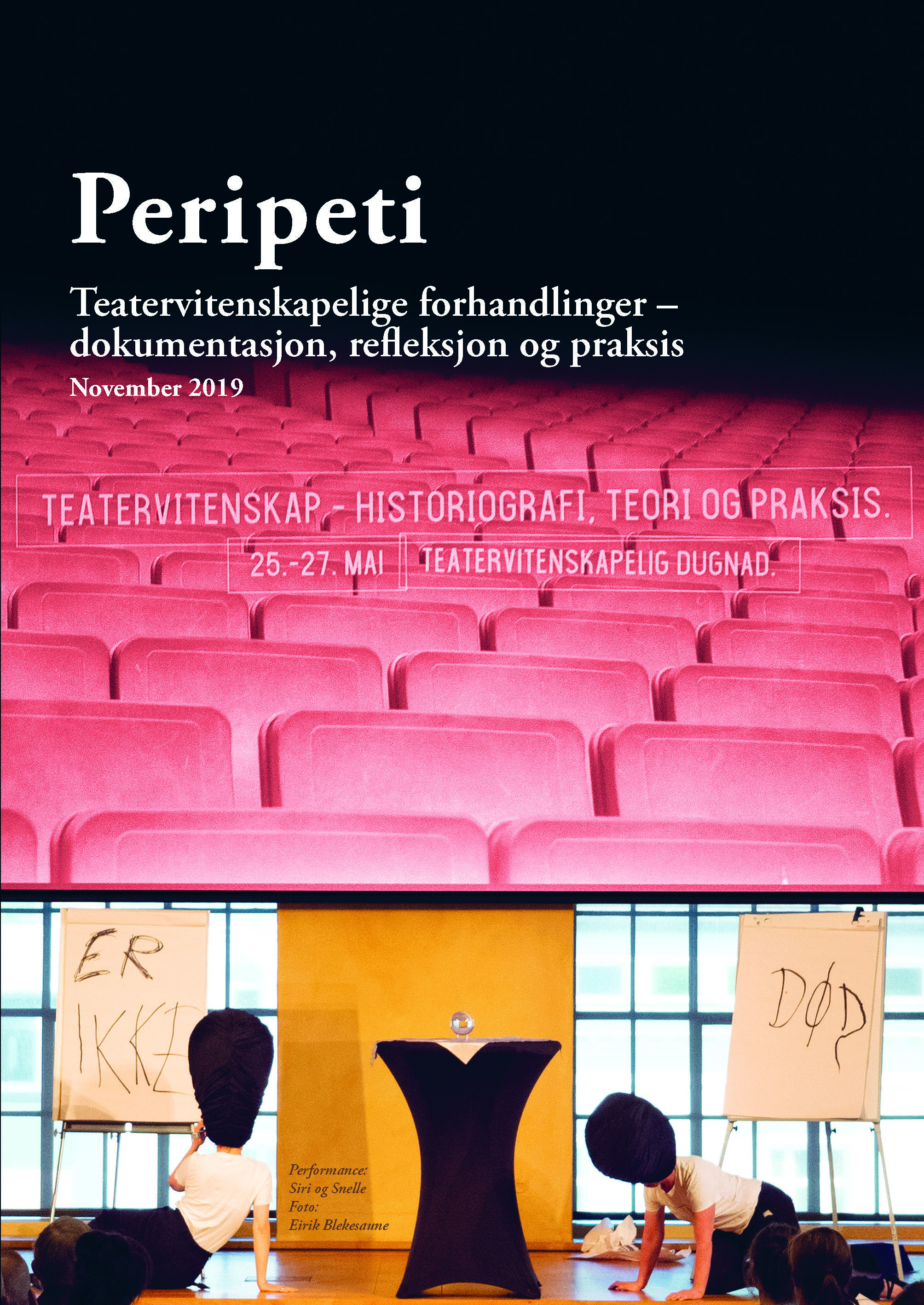Teater som mediator i konfliktområder
Teater og kulturproduksjon i Patani-regionen
DOI:
https://doi.org/10.7146/peri.v16iS8.117598Resumé
Fremveksten av religiøs radikalisme og ekstremisme i dagens samfunn gir inntrykk av en uoverkommelig polarisering mellom ulike folkegrupper, etnisiteter og individer tilhørende ulike religioner. Artikkel diskuterer med utgangspunkt i teatervirksomheten i Pataniregionen i Malaysia og Thailand og hvordan en kulturell fellesarv kommer til uttrykk i teateret og bidrar til å nyansere forestillinger om «rene» religioner og identiteter.
The emergence of radical extremism gives the impression of increasing religious and cultural opposition in today’s society. The article discusses how a deeper cultural understanding expressed through the theater in Patani Region in Malaysia and Thailand can help to nuance this picture.
Referencer
Avruch, K. (1998) Culture and Conflict Resolution. United States Institute of Peace Press. Washington DC.
Brandon, J. (1974) Theatre in Southeast Asia. Harvard University Press
Brandon, J. (1993) On Thrones of gold: Three Javanese Shadow Plays. Honolulu: University of Hawaii Press.
Chalermpow Koanantakol, P (1989) Relevance of rhe Textual and Contextual Analysis in Understanding Folk Peformances in Modern Society: A Case of Southern Thai Shadow Puppet Theatre. Asian Folklore Studies. Vol 18, No 1, s 31 – 57.
Dowsey-Magog, P. (2002) Popular Workers’Shadow Theatre in Thailand. Asian Theatre Journal, 19, 184-211.
Dowsey-Magog, P. (2005) Popular Culture and Traditional Performance: Conflicts and Challenges in Contemporary Nang Talung. I Sungannasil (ed) Dynamic Diversity in South Thailand. Prince of Songkla University. Silkworm Books.
Endicott, K (1981) An Analysis of Malay Magic. Oxford: Oxford University Press.
Ghulam-Sarwar, Y 1976: The Kelantan Mak Yong Dance Theatre. A study of performance structure. University of Hawaii Ph.d 1976
Ghulam-Sarwar, Y (1994) Dictionary of Traditional South-East Asian Theatre. . Oxford University Press . Kuala Lumpur
Guelden, M. (2005) Spirit Mediumship in Southern Thailand: The feminization of Nora Ancestral Possession. I Sugunnasil, W (ed) Dynamic Diversity in Southern Thailand. Prince of Songkla University. Silkworm Books.
Hall D. G. E. A (1970) History of South-East Asia, London: Macmillan/New York: St. Martin’s Press, 1970.
Horstmann, A. (2004) Ethnohistorical Perspectives on Buddhist-Muslim Relations and Coexistence in Southern Thailand: From Shared Cosmos to the Emergence of hatred? Journal of Social Issues in Southeast Asia 19, 76-99.
Horstmann, A. (2011) Living together: The transformation of multi-religious coexistence in southern Thailand. Journal of Southeast Asian Studies.42 (3) s.487 – 510.
Horstmann, A. (2012) Manora Ancestral Beings, Possesion and Cosmic Rejuvenation in Southern Thailand: modern Adaptions of the Multi-religious Manora Ancestral Vow Ceremony. Anthropos 107, 103 -114
Johnson,I (2006) Little Bear Sells CDs and Ai Theng Drinks Coke: Sacred Clowning and the Politics of Regionalism in South Thailand. Journal of Social issues in Southeast Asia, Volume 21,2.
Jungwiwattanaporn, P. (2006) In contact with the dead: Nora Rong Khru Chao Ban Ritual of Thailand. Asian Theatre Journal 23, 374 – 395
Kingsley, J (2017) Dynamics of Religion in Southeast Asia: Magic and Modernity. The Asia Pacific Journal of Anthropology 18:3, 266-268
Kvam, H (2005) Den tapte ritus. Malaysisk Mak Yong-teater i transformasjon fra ruralt til nasjonalt teater. Dr. avhandling NTNU
Kvam, H (2015) Accessing Shared Culture for Conflict transformation. Journal of Urban Culture Research. 10, 40-51
Mohd. Taib Osman (1967) Indigenous, Hindu and Islamic Elements in Malay Folk Beliefs. Indiana: Indiana University Press.
Matusky, P. (1980) Music in the Malay Shadow Theatre. Ph.D Ann Arbor 1980
Osnes, Beth 2010: The Shadow Puppet Theatre of Malaysia. McFarland & Company, Inc., Publishers.
Reuter, T. og Horstmann, A. (2013) Faith in the Future Understanding the Revitalization of religions and Cultural Traditions in Asia. Leiden: Brill.
Roff, W.R. (1974) Religion, Society and Politics in a Malay State. Kuala Lumpur: Oxford University Press.
Sungunnasil,W (ed) (2005) Dynamic Diversity in Southern Thailand. Prince of Songkla University. Silkworm Books.
Sweeny, A. (1972 A) The Ramayana and the Malay Shadow Play. Kuala Lumpur: Pernerbit Universiti Kebangsaan Malaysia.
Sweeny, A (1972 B) Malay Shadow Puppets. The Trustees of British Museum.
Wen Zha (2017) Trans-border ethnic groups and interstate relations within ASEAN: a case study on Malaysia and Thailand’s southern conflict. International Relations of the Asia-Pacific, Volume 17
Winstedt, R (1982) The Malay magician. Oxford University Press.
Wright, B (1980) Wayang Siam, An ethnographic study of Malay Shadow Play of Kelantan. Ph.D Yale University
Publiceret
Citation/Eksport
Nummer
Sektion
Licens
Det følgende vedrører alle Peripeti-udgivelser fra 2024, nr. 39, og senere:
Peripeti er et Diamond Open Access-tidsskrift, der giver direkte open acces til publiceret indhold ud fra princippet om, at det at gøre forskning frit tilgængelig for offentligheden understøtter en større global udveksling af viden.
Forfattere skal ikke betale for indsendelse, redigering eller offentliggørelse af artikler.
Forfattere, der bidrager til Peripeti, bevarer ophavsretten til deres artikler.
Forfattere accepterer at udgive artikler under en Creative Commons CC-BY-NC 4.0-licens. Vilkårene for denne licens tillader brugere frit at kopiere og videredistribuere materialet i ethvert medie eller format og at tilpasse, transformere og bygge videre på materialet, så længe der gives passende kreditering, et link til licensen gives, og eventuelle ændringer angives. Brugere må ikke dele eller tilpasse materialet til kommercielle formål uden samtykke fra licensgiveren. Brugen af licensen må ikke på nogen måde antyde, at licensgiveren støtter tredjeparten eller dennes brug. Licensen kan ikke tilbagekaldes.
Forfattere opfordres til at lægge deres artikler ud på personlige og/eller institutionelle hjemmesider for at sikre endnu større offentlig adgang efter udgivelsen. Forfattere har ret til at arkivere deres artikler i fondes og offentlige institutioners arkiver, men Peripeti anmoder om, at forfattere bruger et direkte link til den publicerede artikel på tidsskriftets hjemmeside, når det er muligt, da Peripeti som en ikke-kommerciel, offentligt finansieret udgiver er afhængig af niveauet af brugeraktivitet på tidsskriftets hjemmeside.
Vedrørende tidligere udgivelser, indtil 2024, herunder nr. 38:
Ophavsretten deles mellem Peripeti og forfatteren/forfatterne. Tidsskriftet er et open access-tidsskrift, der giver direkte adgang til alt indhold baseret på princippet om, at det at gøre forskning frit tilgængelig for offentligheden understøtter en større global udveksling af viden. Brugere kan frit kopiere og dele materiale i ethvert medie eller format, så længe der gives passende kreditering. Enhver anden brug kræver skriftligt samtykke fra indehaverne af ophavsretten.





